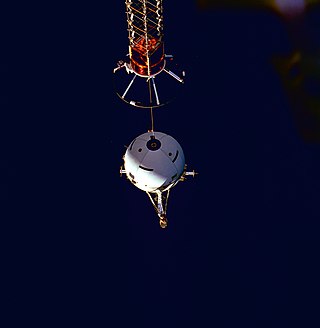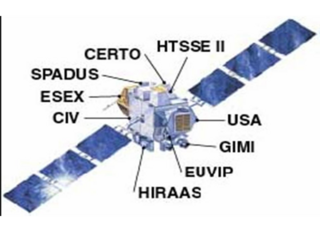Related Research Articles

The ionosphere is the ionized part of the upper atmosphere of Earth, from about 48 km (30 mi) to 965 km (600 mi) above sea level, a region that includes the thermosphere and parts of the mesosphere and exosphere. The ionosphere is ionized by solar radiation. It plays an important role in atmospheric electricity and forms the inner edge of the magnetosphere. It has practical importance because, among other functions, it influences radio propagation to distant places on Earth. It also affects GPS signals that travel through this layer.

The Pioneer Venus project was part of the Pioneer program consisting of two spacecraft, the Pioneer Venus Orbiter and the Pioneer Venus Multiprobe, launched to Venus in 1978. The program was managed by NASA's Ames Research Center.

STS-75 was a 1996 NASA Space Shuttle mission, the 19th mission of the Columbia orbiter.

FalconSAT is the United States Air Force Academy's (USAFA) small satellite engineering program. Satellites are designed, built, tested, and operated by Academy cadets. The project is administered by the USAFA Space Systems Research Center under the direction of the Department of Astronautics. Most of the cadets who work on the project are pursuing a bachelor of science degree in astronautical engineering, although students from other disciplines join the project.

The Global Geospace Science (GGS) Polar satellite was a NASA science spacecraft designed to study the polar magnetosphere and aurorae. It was launched into orbit in February 1996, and continued operations until the program was terminated in April 2008. The spacecraft remains in orbit, though it is now inactive. Polar is the sister ship to GGS Wind.
The Space Test Program (STP) is the primary provider of spaceflight for the United States Department of Defense (DoD) space science and technology community. STP is managed by a group within the Advanced Systems and Development Directorate, a directorate of the Space and Missile Systems Center of the United States Space Force. STP provides spaceflight via the International Space Station (ISS), piggybacks, secondary payloads and dedicated launch services.
The Multi-Application Survivable Tether (MAST) experiment was an in-space investigation designed to use CubeSat spacecraft connected by tethers to better understand the survivability of tethers in space. It was launched as a secondary payload on a Dnepr rocket on 17 April 2007 into a 98°, 647 x 782 km orbit. The MAST payload incorporated three picosatellites, named "Ralph," "Ted," and "Gadget," which were intended to separate and deploy a 1 km (0.62 mi) tether. The experiment hardware was designed under a NASA Small Business Technology Transfer (STTR) collaboration between Tethers Unlimited, Inc. (TUI) and Stanford University, with TUI developing the tether, tether deployer, tether inspection subsystem, satellite avionics, and software, and Stanford students developing the satellite structures and assisting with the avionics design.
FedSat was an Australian scientific research satellite launched from Tanegashima Space Center, Japan by a NASDA H-IIA launch vehicle on 14 December 2002. The satellite was developed by the Cooperative Research Centre for Satellite Systems, a cooperative made up of several universities, commercial organisations and government bodies. The ground station was at the Institute for Telecommunications Research, part of the University of South Australia, near Adelaide. Since 2005 it was operated by the Australian Department of Defence.

The Advanced Research and Global Observation Satellite (ARGOS) was launched on 23 February 1999 carrying nine payloads for research and development missions by nine separate researchers. The mission terminated on 31 July 2003.

C/NOFS, or Communications/Navigation Outage Forecasting System was a USAF satellite developed by the Air Force Research Laboratory (AFRL) Space Vehicles Directorate to investigate and forecast scintillations in the Earth's ionosphere. It was launched by an Orbital Sciences Corporation Pegasus-XL launch vehicle at 17:02:48 UTC on 16 April 2008 and decayed on 28 November 2015.

PicoSAT, launched on September 30, 2001, is a real time tracking satellite. The name "PICO" combines the first letters of all four of its experiments. PICOSat series are designed for a minimum of one year of on-orbit operations.
The Coherent Electromagnetic Radio Tomography (CERTO) is a radio beacon which measures ionospheric parameters in coordination with ground receivers. CERTO provides global ionospheric maps to aid prediction of radio wave scattering. CERTO was developed by the Naval Research Lab and is one of the 4 experiment packages aboard the PicoSAT satellite. CERTO provides near–real-time measurements of the ionosphere. CERTO was used for the Equatorial Vortex Experiment in 2013.
The Ionospheric Occultation Experiment (IOX) was a remote sensing satellite package that used a dual frequency Global Positioning System (GPS) receiver to measure properties of the ionosphere. IOX demonstrated remote sensing techniques for future United States Department of Defense space systems and helped to improve operational models for ionospheric and thermospheric forecasts.
The On-Orbit Mission Control will be conducted by the Surrey Satellite Technology Ltd ground site in Guildford, UK. The United States Air Force Academy at Colorado Springs, Colorado will operate a backup ground station for PicoSAT satellite to increase the amount of experimental data.

RAX-2 is a CubeSat satellite built as a collaboration between SRI International and students at the University of Michigan College of Engineering. It is the second spacecraft in the RAX mission. The RAX-1 mission ended after approximately two months of operation due to a gradual degradation of the solar panels that ultimately resulted in a loss of power. RAX team members applied the lessons learned from RAX-1 to the design of a second flight unit, RAX-2, which performs the same mission concept of RAX-1 with improved bus performance and additional operational modes. Science measurements are enhanced through interactive experiments with high power ionospheric heaters where FAI will be generated on demand.

PhoneSat is an ongoing NASA project of building nanosatellites using unmodified consumer-grade off-the-shelf smartphones and Arduino platform and launching them into Low Earth Orbit. This project is part of NASA's Small Spacecraft Technology Program and was started in 2009 at NASA Ames Research Center.
CSES , or Zhangheng, is a Chinese–Italian space mission dedicated to monitoring electromagnetic field and waves, plasma parameters and particle fluxes induced by natural sources and artificial emitters in the near-Earth space. Austria contributes to one of the magnetometers.

Explorer 27 was a small NASA satellite, launched in 1965, designed to conduct scientific research in the ionosphere. It was powered by 4 solar panels. One goal of the mission was to study in detail the shape of the Earth by way of investigating variations in its gravitational field. It was the third and last of the Beacons in the Explorers program. The satellite was shut off in July 1973 so that its transmission band could be used by higher-priority spacecraft.

Explorer 22 was a small NASA ionospheric research satellite launched 9 October 1964, part of NASA's Explorer Program. It was instrumented with an electrostatic probe, four radio beacons for ionospheric research, a passive laser tracking reflector, and two radio beacons for Doppler navigation experiments. Its objective was to provide enhanced geodetic measurements of the Earth as well as data on the total electron content in the Earth's atmosphere and in the satellite's immediate vicinity.

SpaceX CRS-27, also known as SpX-27, was a Commercial Resupply Service mission to the International Space Station (ISS) launched on 15 March 2023. The mission was contracted by NASA and was flown by SpaceX using Cargo Dragon C209. This was the seventh flight for SpaceX under NASA's CRS Phase 2.
References
![]() This article incorporates public domain material from websites or documents of the National Aeronautics and Space Administration .
This article incorporates public domain material from websites or documents of the National Aeronautics and Space Administration .